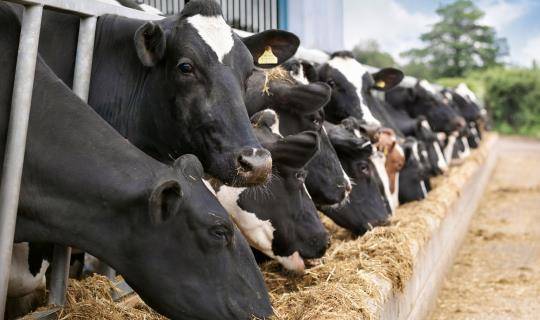How to address pressing staffing shortages in the production animal health sector
By MWI Animal Health

Livestock veterinary practices are having trouble filling open positions, with the USDA reporting that 500 counties across the country have a shortage of qualified veterinarians to care for food animals on farms and ranches, The demand for jobs continues to outpace the supply of qualified and more importantly, interested, applicants. Food animal veterinarians only comprise about four percent of veterinarians in the United States, so veterinary students may not be pursuing this line of employment.
This is concerning because those who care for our livestock provide an invaluable service to the economy and to our well-being. Food animal veterinarians are an integral part of the OneHealth concept, the interconnectedness between human health, animal health, and the health of our environment. Besides sustaining animals' welfare, food animal veterinarians ensure the safety of the food we eat. They also ensure fiscal stability throughout the food supply chain by diagnosing, treating, and preventing potentially catastrophic emerging and zoonotic diseases.
And labor shortages extend to the producers and other staff needed to run those farms and ranches. A survey of dairy farm labor practices by FARM Workforce Development showed a 38.8 percent average turnover rate.3 The farms self-rated the difficulty of finding talent replacement labor a four out of five. A study of feed yard managers in Texas revealed 79 percent admitted to having "lots of difficulty" retaining employees in the cattle sector.
How can these industries convince qualified applicants to choose them as a place of work and entice them to stay?
Compensation as a recruitment tool
The American Veterinary Medical Association reported that in 2021, the average salary for veterinarians working exclusively or primarily with food animals was $85,000. Consider that those in companion practices can pull in six figures as a starting salary and you can understand it can be an difficult choice to enter this market.Student debt weighs many new graduates down, and that burden could influence the job offers they ultimately accept. Sixty percent of the DVM class of 2026 entered veterinary school already in debt from their undergraduate education. In addition to that, median vet school tuition in the United States is $55,000 per year, so it's clear that these financial concerns weigh heavily on the next generation of employees.
Practices in underserved areas can market themselves to prospective employees by touting the Veterinary Medicine Loan Repayment Program. Sponsored by the USDA, the program gives veterinarians who agree to work for three years in a region deemed as having a veterinary practitioner shortage $25,000 per year to put toward their qualified educational loans.
Should I stay or should I go?
To attract a qualified veterinarian to your practice, then, the compensation must meet a certain level. Yet beyond salary, there are other considerations that may entice a veterinarian to consider working at a particular practice. According to CAST, which studied recruitment and retention of food animal veterinarians, graduating veterinary students want:
- High salaries
- Good practice atmosphere and mentorship
- Good facilities, caseload, and ability to use skills
- Work/life balance
Recent (less than 8 years experience) graduate members of the American Association of Bovine Practitioners shared their thoughts on the state of the industry in a series of focus groups. A love for the industry and its people and a sense of professional fulfillment was the driving factor for choosing and staying in bovine practice.
The top concern or reason for potentially leaving practice was the fear of suffering a career-ending injury. This fear is not unfounded, as multiple focus group participants had already sustained injuries, including back injuries, arm injuries, and carpal tunnel syndrome.9 Practice owners, then, should consider including safety education and training as part of both new hire on-boarding and on-going employee education. Although these topics are taught in veterinary schools, it needs to be a continuous conversation. Investing in additional safety mechanisms, such as proper equipment, and training employees on the newest techniques for safe animal handling can alleviate some of those injury concerns.
Other sentiments echoed the CAST survey. Reasons early career veterinarians could potentially leave bovine practice included lack of work-life balance, lack of mentors, and a sense of isolation. Veterinary practices should consider integrating solutions that can address such concerns, such as mentorship programs and team engagement workshops. Putting forth the effort can show that they support the career growth and the overall well-being of their early career employees, which can pay off later down the road when those employees are exploring new possibilities.
Those who care for our livestock provide an invaluable service to the economy and our well-being.
What's happening on the farm and ranch?
Producers too, are feeling the need for more qualified labor. FARM Workforce Development found the average hourly wage for dairy employees is $13.90. For salaried dairy employees, the average is $65,301 per year.39 percent of farm and ranch operators surveyed by Nebraska Farm Bureau offered no benefits to production animal workers. Of those that did offer benefits, complimentary meat was the most common benefit, with 47 percent offering that perk. 30 percent of employers offered housing; 26 percent offered paid time off; and 21 percent provided company-supported health insurance.
With tight markets in the food animal sector, offering more competitive benefits, could be a way to entice more applicants to jobs—and encourage them to stay. It may be money well spent. The cost of replacing an employee can be up to 20 percent of their salary, and even adding a few benefits would keep farms and feed yards on the right side of the balance sheet. One survey of feed yard employees in Texas showed more than half (57 percent) were unsure if they would encourage their children to enter the industry, so changes may be needed to sustain the next generation of labor in this vital industry.
There is some encouraging news, however. The majority of feed yard employees were satisfied with their jobs and coworkers, with 77 percent in cattle departments believing their expectations for their job were met.
Technology enables job satisfaction
The right technology in the farm or feedlot can encourage efficiency, which in turn, lowers stress and raises job satisfaction. What tools do you have in place and how are staff using them to their advantage?Automate wherever possible, especially essential, yet recurring tasks, such as measuring and delivering the right mix of feed to the right animals. Ask yourself: Are feed delivery mechanisms automated? Are you using technology for superior animal health inventory management? Is the milking process enabled by the right software and data that allows your dairy staff to respond to changes affecting the business in real time? In the feed yard, are you using a single inventory system to seamlessly manage feed, health, and other animal data?
Consider upgrading your platforms and solutions as a way to attract and retain the next generation of talent.
Keep an eye on mental health
We've all heard and empathized with the sobering stats on the mental health crises and suicide rates in the veterinary industry. The Merck Animal Health Veterinarian Wellbeing Study III and Veterinary Support Staff Study showed 59 percent of distressed veterinarians and 65 percent of distressed veterinary support needed mental health treatment in the past year but did not get it.
According to NYFarmNet.org, signs someone may be struggling include:
- Changes in routine or social activities
- Decline in care of domestic animals
- Increase in illness or chronic conditions
- Increase in farm accidents
- Decline in the appearance of the farmstead
- Decreased interest in activities or events
Whether you run a veterinary practice, feed yard, dairy farm, or another production animal business, frequently checking the pulse of your team is a smart way to keep staff engaged. Performing engagement scoring using the voice of the employee surveys and other similar tools will provide benchmarks for growth. By asking the right questions, you can quantify any changes made and get the team to stop and think about how — or even if — it has improved. Take advantage of the opportunities to discuss engagement scoring at team meetings to help promote open discussion and psychological safety in the workplace.
Hiring and retention in the production animal industry is facing some strong headwinds. Improving employee benefits, offering mentoring for early career workers, and making compensation more competitive are a few ways to attract smart, dedicated talent into this vital sector.




